La Trobe University ACC3TAX: Taxation Assignment Solution - SP1 2019
VerifiedAdded on 2023/03/17
|8
|1656
|94
Homework Assignment
AI Summary
This document provides a comprehensive solution to a taxation assignment, focusing on the tax implications for Chris Matthews. The analysis begins with determining the capital gains tax (CGT) liability arising from the sale of a house, including calculations for capital proceeds, cost base, and applicable discounts. It then addresses the deductibility of legal fees incurred for defending a lawsuit, referencing relevant legislation and case law to determine if such expenses can be deducted from taxable income. Finally, the solution outlines the appropriate accounting method for professionals, specifically the cash basis method, and includes detailed calculations of Mr. Matthews's taxable income, deductions, and tax payable, incorporating relevant tax brackets and levies. The document concludes with a bibliography of the cited legal and case references.
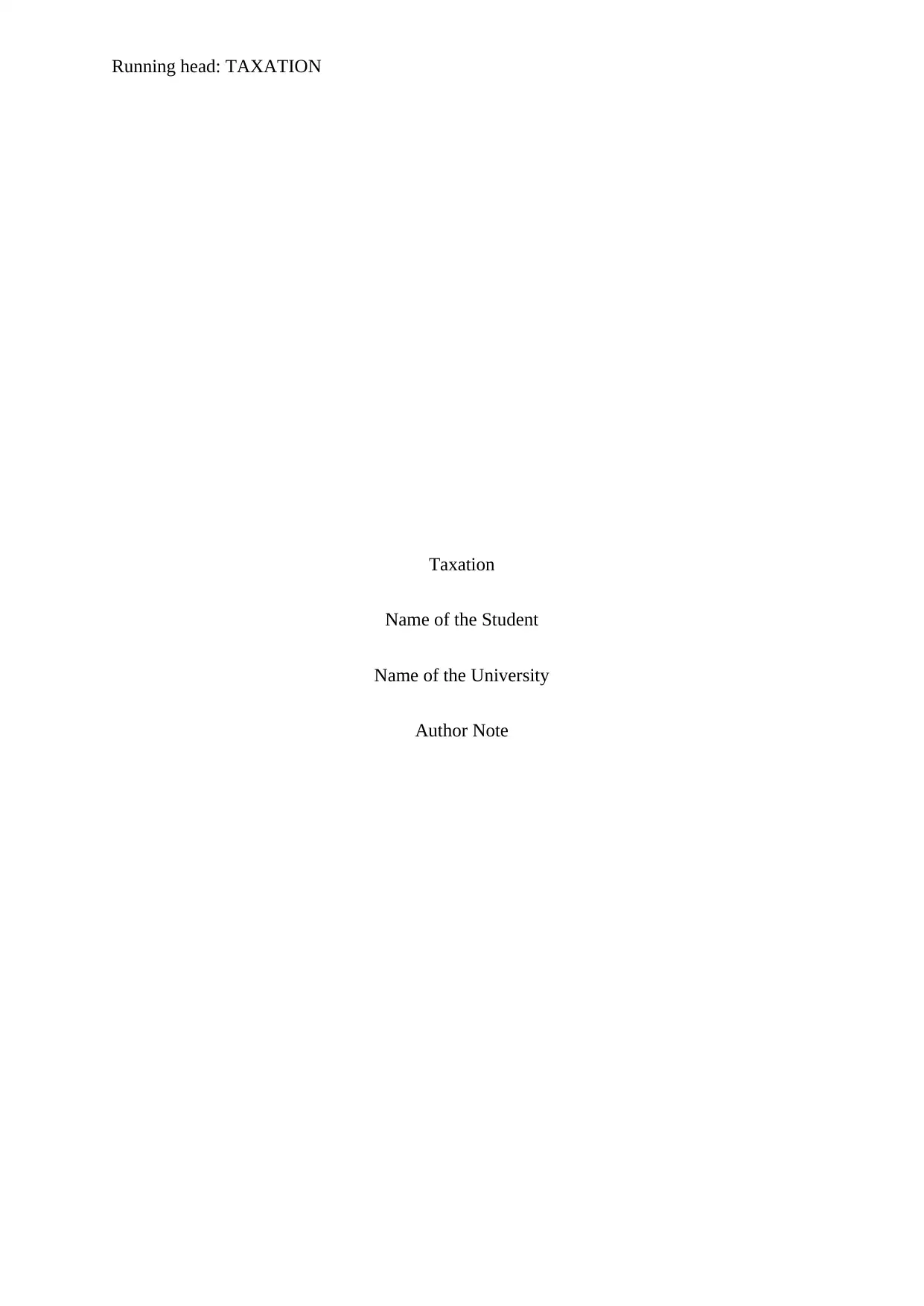
Running head: TAXATION
Taxation
Name of the Student
Name of the University
Author Note
Taxation
Name of the Student
Name of the University
Author Note
Paraphrase This Document
Need a fresh take? Get an instant paraphrase of this document with our AI Paraphraser
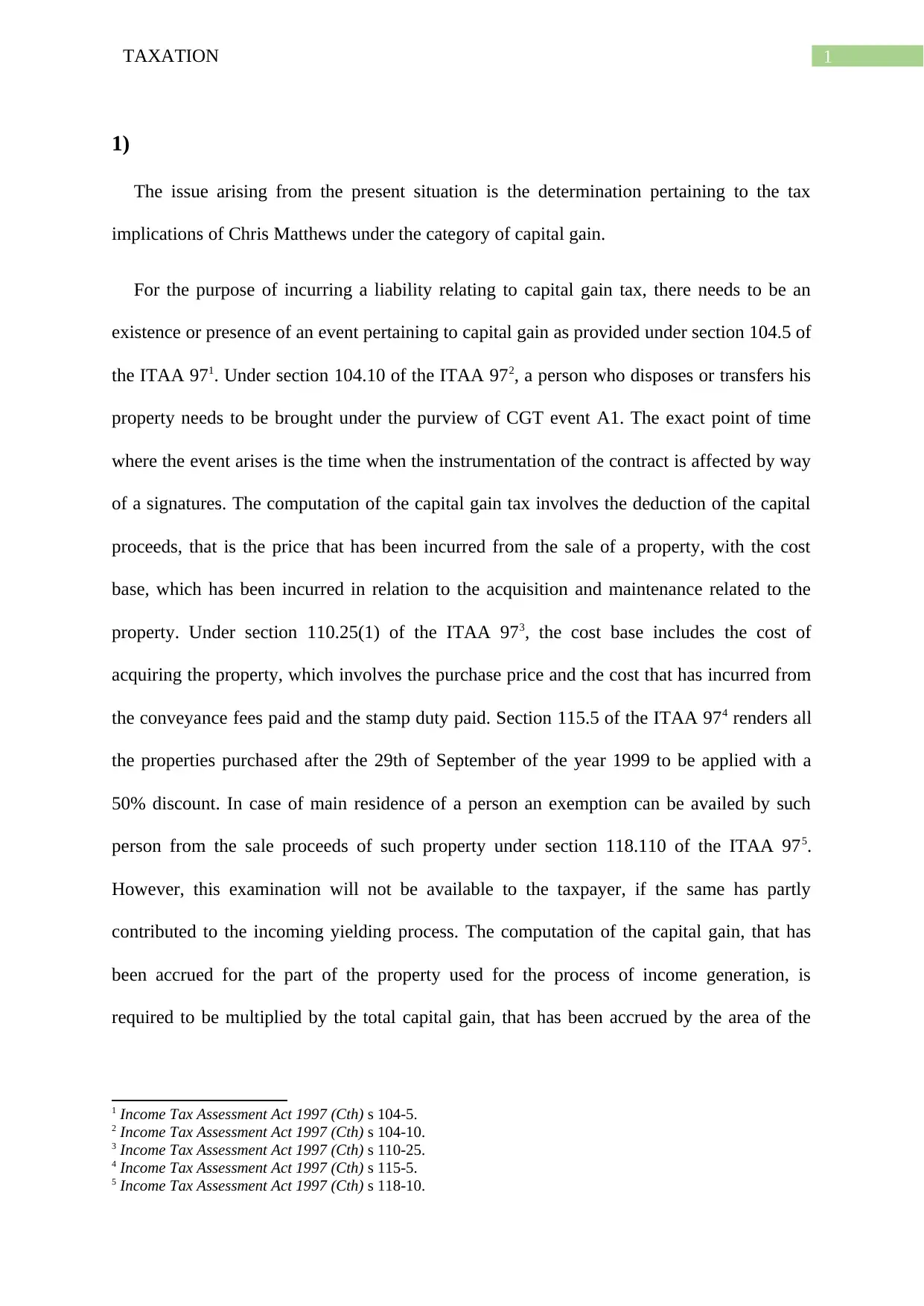
1TAXATION
1)
The issue arising from the present situation is the determination pertaining to the tax
implications of Chris Matthews under the category of capital gain.
For the purpose of incurring a liability relating to capital gain tax, there needs to be an
existence or presence of an event pertaining to capital gain as provided under section 104.5 of
the ITAA 971. Under section 104.10 of the ITAA 972, a person who disposes or transfers his
property needs to be brought under the purview of CGT event A1. The exact point of time
where the event arises is the time when the instrumentation of the contract is affected by way
of a signatures. The computation of the capital gain tax involves the deduction of the capital
proceeds, that is the price that has been incurred from the sale of a property, with the cost
base, which has been incurred in relation to the acquisition and maintenance related to the
property. Under section 110.25(1) of the ITAA 973, the cost base includes the cost of
acquiring the property, which involves the purchase price and the cost that has incurred from
the conveyance fees paid and the stamp duty paid. Section 115.5 of the ITAA 974 renders all
the properties purchased after the 29th of September of the year 1999 to be applied with a
50% discount. In case of main residence of a person an exemption can be availed by such
person from the sale proceeds of such property under section 118.110 of the ITAA 975.
However, this examination will not be available to the taxpayer, if the same has partly
contributed to the incoming yielding process. The computation of the capital gain, that has
been accrued for the part of the property used for the process of income generation, is
required to be multiplied by the total capital gain, that has been accrued by the area of the
1 Income Tax Assessment Act 1997 (Cth) s 104-5.
2 Income Tax Assessment Act 1997 (Cth) s 104-10.
3 Income Tax Assessment Act 1997 (Cth) s 110-25.
4 Income Tax Assessment Act 1997 (Cth) s 115-5.
5 Income Tax Assessment Act 1997 (Cth) s 118-10.
1)
The issue arising from the present situation is the determination pertaining to the tax
implications of Chris Matthews under the category of capital gain.
For the purpose of incurring a liability relating to capital gain tax, there needs to be an
existence or presence of an event pertaining to capital gain as provided under section 104.5 of
the ITAA 971. Under section 104.10 of the ITAA 972, a person who disposes or transfers his
property needs to be brought under the purview of CGT event A1. The exact point of time
where the event arises is the time when the instrumentation of the contract is affected by way
of a signatures. The computation of the capital gain tax involves the deduction of the capital
proceeds, that is the price that has been incurred from the sale of a property, with the cost
base, which has been incurred in relation to the acquisition and maintenance related to the
property. Under section 110.25(1) of the ITAA 973, the cost base includes the cost of
acquiring the property, which involves the purchase price and the cost that has incurred from
the conveyance fees paid and the stamp duty paid. Section 115.5 of the ITAA 974 renders all
the properties purchased after the 29th of September of the year 1999 to be applied with a
50% discount. In case of main residence of a person an exemption can be availed by such
person from the sale proceeds of such property under section 118.110 of the ITAA 975.
However, this examination will not be available to the taxpayer, if the same has partly
contributed to the incoming yielding process. The computation of the capital gain, that has
been accrued for the part of the property used for the process of income generation, is
required to be multiplied by the total capital gain, that has been accrued by the area of the
1 Income Tax Assessment Act 1997 (Cth) s 104-5.
2 Income Tax Assessment Act 1997 (Cth) s 104-10.
3 Income Tax Assessment Act 1997 (Cth) s 110-25.
4 Income Tax Assessment Act 1997 (Cth) s 115-5.
5 Income Tax Assessment Act 1997 (Cth) s 118-10.

2TAXATION
property in percentage that has been utilised for the process of earning income and the
percentage of time for which this area has been used for such of purpose.
In the instant situation, Chris has medicine of his house and this sale can we contribute to
wear CGT event categorised as A1. The sale of the house has earned a sell proceed of
$1000000. The cost base that has been included in the cost price amounting to $400000,
stamp duty amounting to $20,000 and a conveyance fee amounting to $8000. The capital gain
would be capital proceeds minus cost base. On the other hand, the taxation would only be
imposed upon that part of the house of the Mr Matthews that has been used for business
purposes. The total area, in this case, is 200 metre square metre and the part of business is
only 10 metre square. Hence, the percentage of the house that has been used for business
purposes was 5%. Again, the house has been purchased in 1999 and the sale has been
affected in 2018, but the business started in 2004. Hence, the percentage of time will also be
required to be taken into consideration. For the purpose of business, the time will be divided
by 1447/7050 (days) * 100 = 20.52%. The CGT computation for Mr Matthews is as follows:
PARTICULAR
S
AMOUN
T
AMOUN
T
CP 1000000
CB
E 1 400000
E 2 (conveyance fees) 8000
E 2 (Stamp Duty) 20000
Total CB -428000
Area used commercially
(572000*0.20.52*0.05)
5870
property in percentage that has been utilised for the process of earning income and the
percentage of time for which this area has been used for such of purpose.
In the instant situation, Chris has medicine of his house and this sale can we contribute to
wear CGT event categorised as A1. The sale of the house has earned a sell proceed of
$1000000. The cost base that has been included in the cost price amounting to $400000,
stamp duty amounting to $20,000 and a conveyance fee amounting to $8000. The capital gain
would be capital proceeds minus cost base. On the other hand, the taxation would only be
imposed upon that part of the house of the Mr Matthews that has been used for business
purposes. The total area, in this case, is 200 metre square metre and the part of business is
only 10 metre square. Hence, the percentage of the house that has been used for business
purposes was 5%. Again, the house has been purchased in 1999 and the sale has been
affected in 2018, but the business started in 2004. Hence, the percentage of time will also be
required to be taken into consideration. For the purpose of business, the time will be divided
by 1447/7050 (days) * 100 = 20.52%. The CGT computation for Mr Matthews is as follows:
PARTICULAR
S
AMOUN
T
AMOUN
T
CP 1000000
CB
E 1 400000
E 2 (conveyance fees) 8000
E 2 (Stamp Duty) 20000
Total CB -428000
Area used commercially
(572000*0.20.52*0.05)
5870
⊘ This is a preview!⊘
Do you want full access?
Subscribe today to unlock all pages.

Trusted by 1+ million students worldwide
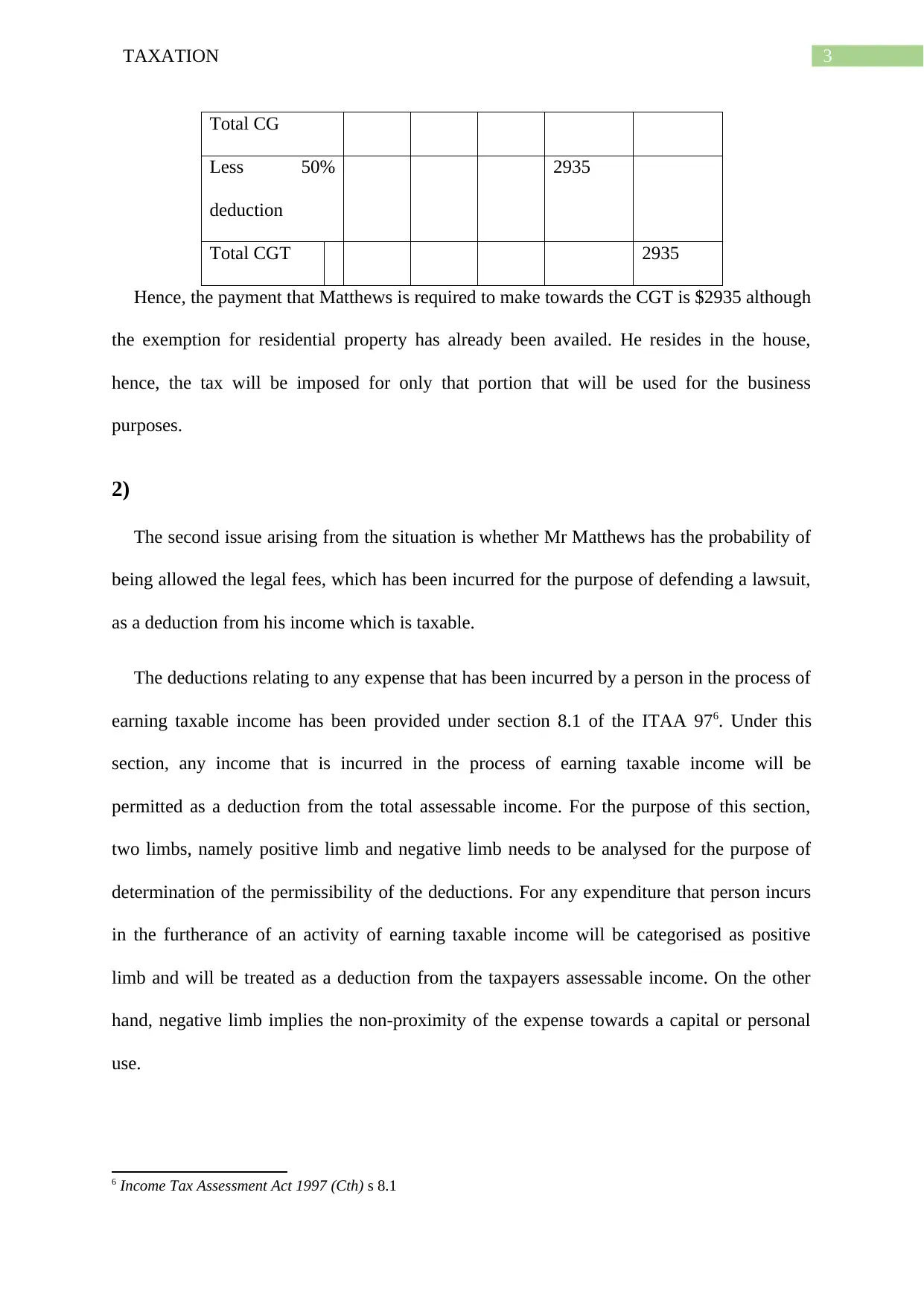
3TAXATION
Total CG
Less 50%
deduction
2935
Total CGT 2935
Hence, the payment that Matthews is required to make towards the CGT is $2935 although
the exemption for residential property has already been availed. He resides in the house,
hence, the tax will be imposed for only that portion that will be used for the business
purposes.
2)
The second issue arising from the situation is whether Mr Matthews has the probability of
being allowed the legal fees, which has been incurred for the purpose of defending a lawsuit,
as a deduction from his income which is taxable.
The deductions relating to any expense that has been incurred by a person in the process of
earning taxable income has been provided under section 8.1 of the ITAA 976. Under this
section, any income that is incurred in the process of earning taxable income will be
permitted as a deduction from the total assessable income. For the purpose of this section,
two limbs, namely positive limb and negative limb needs to be analysed for the purpose of
determination of the permissibility of the deductions. For any expenditure that person incurs
in the furtherance of an activity of earning taxable income will be categorised as positive
limb and will be treated as a deduction from the taxpayers assessable income. On the other
hand, negative limb implies the non-proximity of the expense towards a capital or personal
use.
6 Income Tax Assessment Act 1997 (Cth) s 8.1
Total CG
Less 50%
deduction
2935
Total CGT 2935
Hence, the payment that Matthews is required to make towards the CGT is $2935 although
the exemption for residential property has already been availed. He resides in the house,
hence, the tax will be imposed for only that portion that will be used for the business
purposes.
2)
The second issue arising from the situation is whether Mr Matthews has the probability of
being allowed the legal fees, which has been incurred for the purpose of defending a lawsuit,
as a deduction from his income which is taxable.
The deductions relating to any expense that has been incurred by a person in the process of
earning taxable income has been provided under section 8.1 of the ITAA 976. Under this
section, any income that is incurred in the process of earning taxable income will be
permitted as a deduction from the total assessable income. For the purpose of this section,
two limbs, namely positive limb and negative limb needs to be analysed for the purpose of
determination of the permissibility of the deductions. For any expenditure that person incurs
in the furtherance of an activity of earning taxable income will be categorised as positive
limb and will be treated as a deduction from the taxpayers assessable income. On the other
hand, negative limb implies the non-proximity of the expense towards a capital or personal
use.
6 Income Tax Assessment Act 1997 (Cth) s 8.1
Paraphrase This Document
Need a fresh take? Get an instant paraphrase of this document with our AI Paraphraser
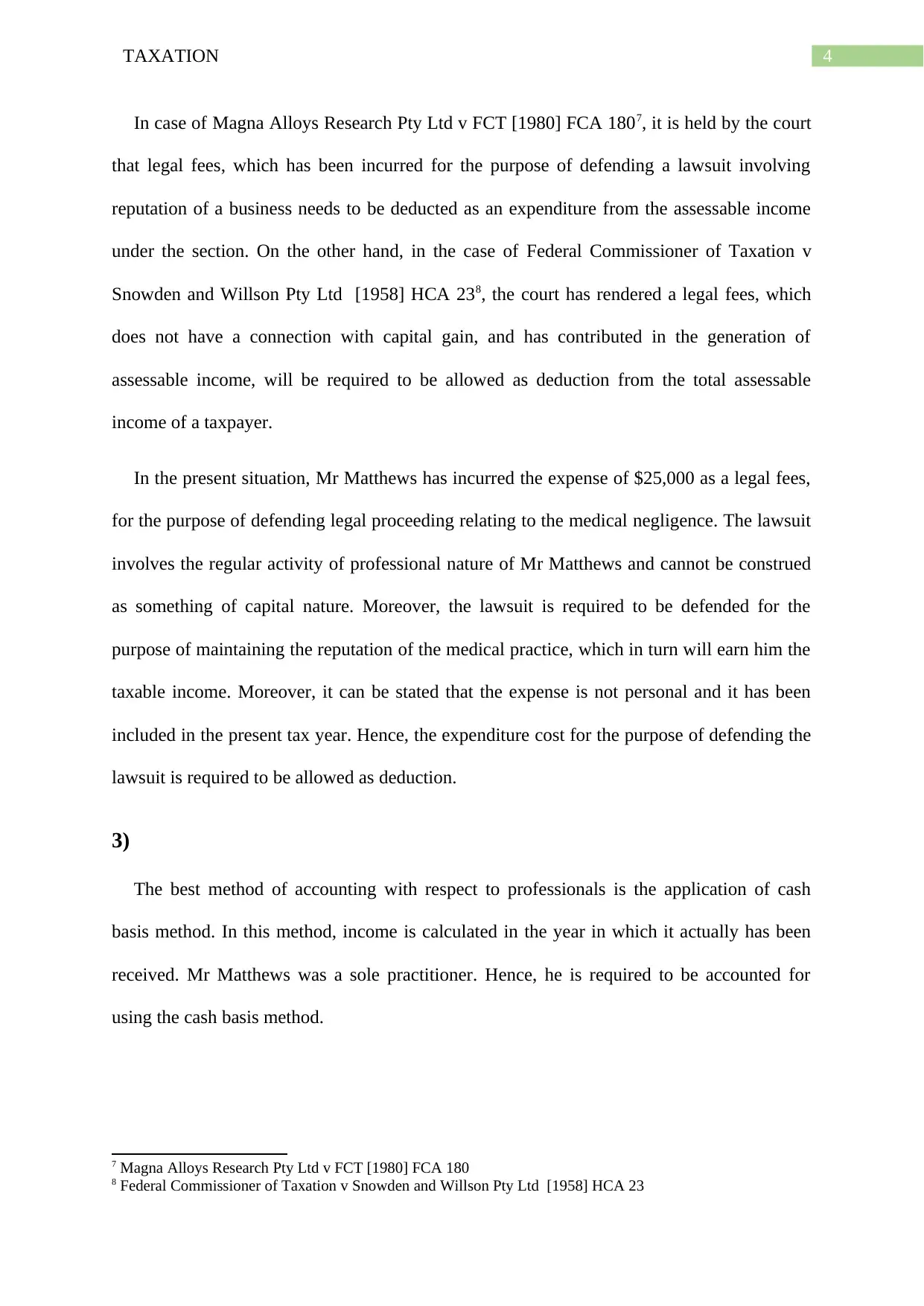
4TAXATION
In case of Magna Alloys Research Pty Ltd v FCT [1980] FCA 1807, it is held by the court
that legal fees, which has been incurred for the purpose of defending a lawsuit involving
reputation of a business needs to be deducted as an expenditure from the assessable income
under the section. On the other hand, in the case of Federal Commissioner of Taxation v
Snowden and Willson Pty Ltd [1958] HCA 238, the court has rendered a legal fees, which
does not have a connection with capital gain, and has contributed in the generation of
assessable income, will be required to be allowed as deduction from the total assessable
income of a taxpayer.
In the present situation, Mr Matthews has incurred the expense of $25,000 as a legal fees,
for the purpose of defending legal proceeding relating to the medical negligence. The lawsuit
involves the regular activity of professional nature of Mr Matthews and cannot be construed
as something of capital nature. Moreover, the lawsuit is required to be defended for the
purpose of maintaining the reputation of the medical practice, which in turn will earn him the
taxable income. Moreover, it can be stated that the expense is not personal and it has been
included in the present tax year. Hence, the expenditure cost for the purpose of defending the
lawsuit is required to be allowed as deduction.
3)
The best method of accounting with respect to professionals is the application of cash
basis method. In this method, income is calculated in the year in which it actually has been
received. Mr Matthews was a sole practitioner. Hence, he is required to be accounted for
using the cash basis method.
7 Magna Alloys Research Pty Ltd v FCT [1980] FCA 180
8 Federal Commissioner of Taxation v Snowden and Willson Pty Ltd [1958] HCA 23
In case of Magna Alloys Research Pty Ltd v FCT [1980] FCA 1807, it is held by the court
that legal fees, which has been incurred for the purpose of defending a lawsuit involving
reputation of a business needs to be deducted as an expenditure from the assessable income
under the section. On the other hand, in the case of Federal Commissioner of Taxation v
Snowden and Willson Pty Ltd [1958] HCA 238, the court has rendered a legal fees, which
does not have a connection with capital gain, and has contributed in the generation of
assessable income, will be required to be allowed as deduction from the total assessable
income of a taxpayer.
In the present situation, Mr Matthews has incurred the expense of $25,000 as a legal fees,
for the purpose of defending legal proceeding relating to the medical negligence. The lawsuit
involves the regular activity of professional nature of Mr Matthews and cannot be construed
as something of capital nature. Moreover, the lawsuit is required to be defended for the
purpose of maintaining the reputation of the medical practice, which in turn will earn him the
taxable income. Moreover, it can be stated that the expense is not personal and it has been
included in the present tax year. Hence, the expenditure cost for the purpose of defending the
lawsuit is required to be allowed as deduction.
3)
The best method of accounting with respect to professionals is the application of cash
basis method. In this method, income is calculated in the year in which it actually has been
received. Mr Matthews was a sole practitioner. Hence, he is required to be accounted for
using the cash basis method.
7 Magna Alloys Research Pty Ltd v FCT [1980] FCA 180
8 Federal Commissioner of Taxation v Snowden and Willson Pty Ltd [1958] HCA 23
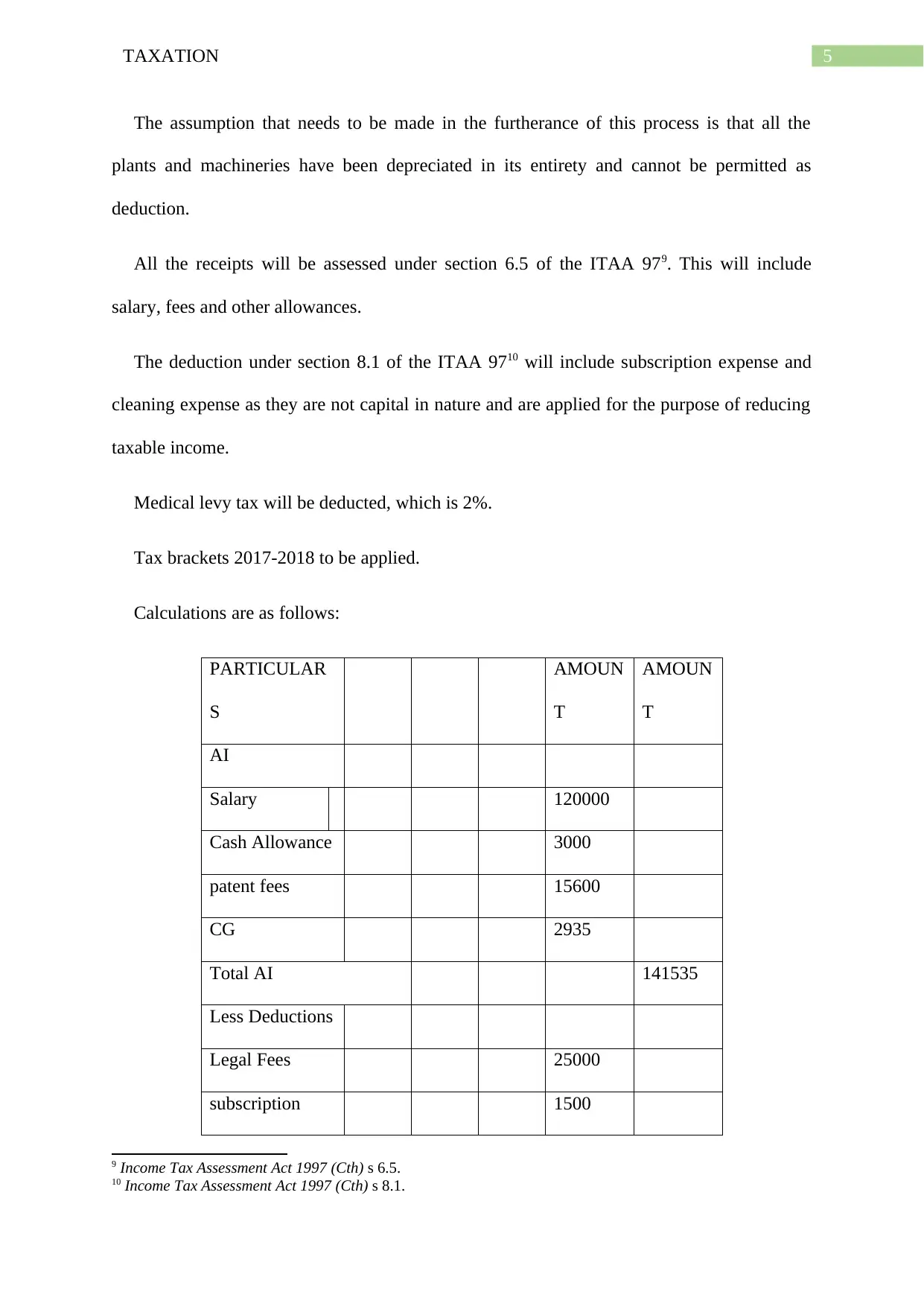
5TAXATION
The assumption that needs to be made in the furtherance of this process is that all the
plants and machineries have been depreciated in its entirety and cannot be permitted as
deduction.
All the receipts will be assessed under section 6.5 of the ITAA 979. This will include
salary, fees and other allowances.
The deduction under section 8.1 of the ITAA 9710 will include subscription expense and
cleaning expense as they are not capital in nature and are applied for the purpose of reducing
taxable income.
Medical levy tax will be deducted, which is 2%.
Tax brackets 2017-2018 to be applied.
Calculations are as follows:
PARTICULAR
S
AMOUN
T
AMOUN
T
AI
Salary 120000
Cash Allowance 3000
patent fees 15600
CG 2935
Total AI 141535
Less Deductions
Legal Fees 25000
subscription 1500
9 Income Tax Assessment Act 1997 (Cth) s 6.5.
10 Income Tax Assessment Act 1997 (Cth) s 8.1.
The assumption that needs to be made in the furtherance of this process is that all the
plants and machineries have been depreciated in its entirety and cannot be permitted as
deduction.
All the receipts will be assessed under section 6.5 of the ITAA 979. This will include
salary, fees and other allowances.
The deduction under section 8.1 of the ITAA 9710 will include subscription expense and
cleaning expense as they are not capital in nature and are applied for the purpose of reducing
taxable income.
Medical levy tax will be deducted, which is 2%.
Tax brackets 2017-2018 to be applied.
Calculations are as follows:
PARTICULAR
S
AMOUN
T
AMOUN
T
AI
Salary 120000
Cash Allowance 3000
patent fees 15600
CG 2935
Total AI 141535
Less Deductions
Legal Fees 25000
subscription 1500
9 Income Tax Assessment Act 1997 (Cth) s 6.5.
10 Income Tax Assessment Act 1997 (Cth) s 8.1.
⊘ This is a preview!⊘
Do you want full access?
Subscribe today to unlock all pages.

Trusted by 1+ million students worldwide
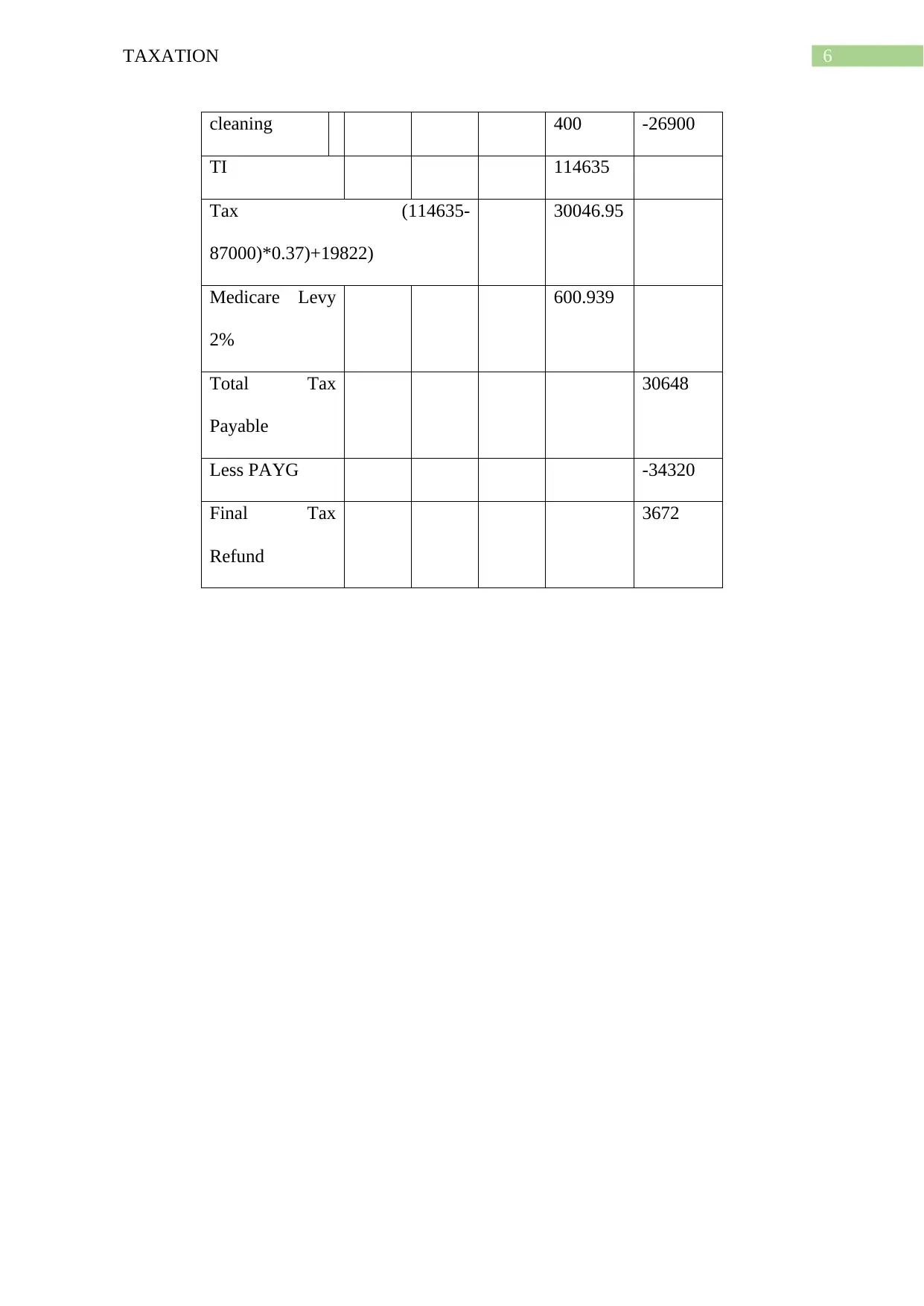
6TAXATION
cleaning 400 -26900
TI 114635
Tax (114635-
87000)*0.37)+19822)
30046.95
Medicare Levy
2%
600.939
Total Tax
Payable
30648
Less PAYG -34320
Final Tax
Refund
3672
cleaning 400 -26900
TI 114635
Tax (114635-
87000)*0.37)+19822)
30046.95
Medicare Levy
2%
600.939
Total Tax
Payable
30648
Less PAYG -34320
Final Tax
Refund
3672
Paraphrase This Document
Need a fresh take? Get an instant paraphrase of this document with our AI Paraphraser
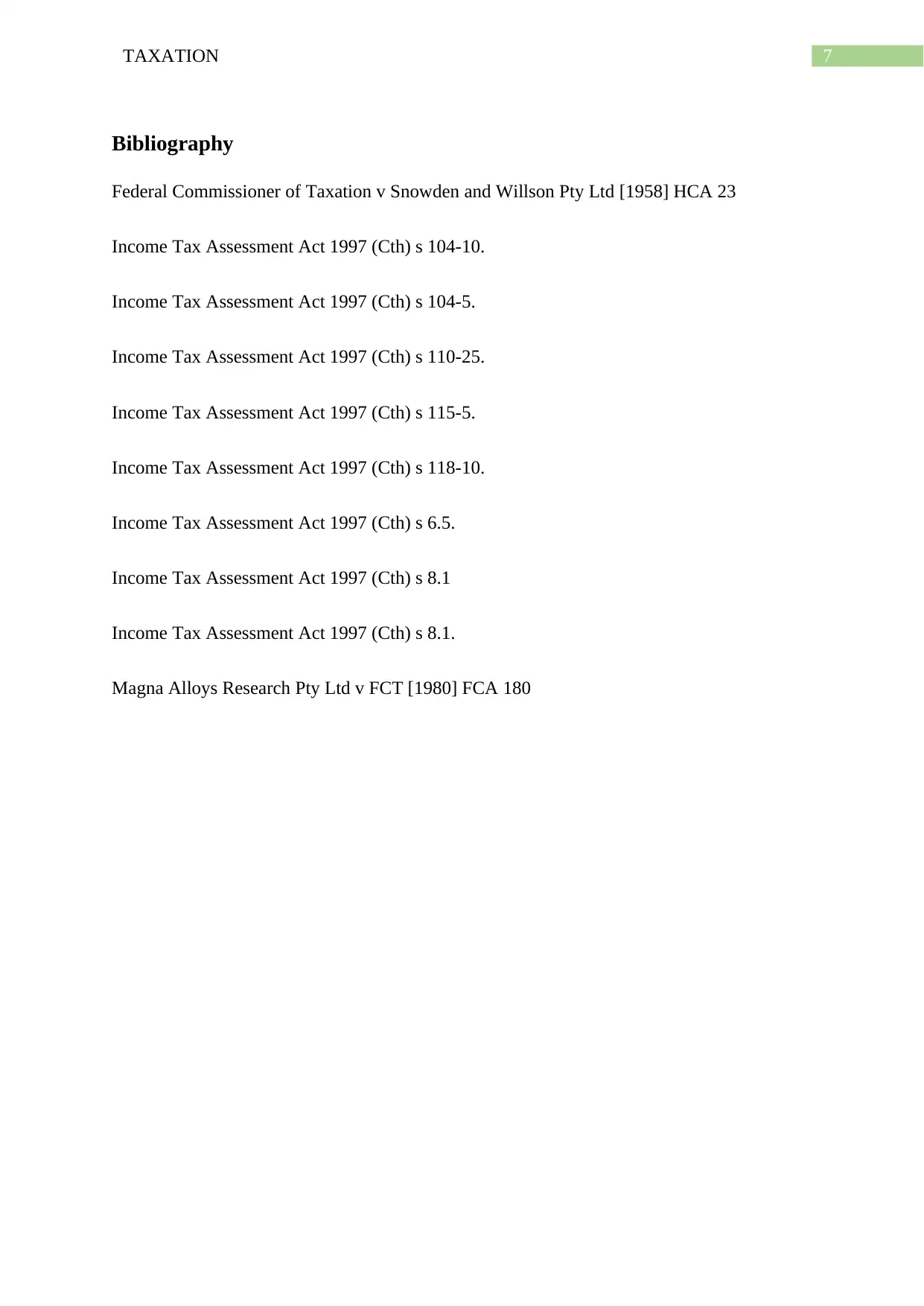
7TAXATION
Bibliography
Federal Commissioner of Taxation v Snowden and Willson Pty Ltd [1958] HCA 23
Income Tax Assessment Act 1997 (Cth) s 104-10.
Income Tax Assessment Act 1997 (Cth) s 104-5.
Income Tax Assessment Act 1997 (Cth) s 110-25.
Income Tax Assessment Act 1997 (Cth) s 115-5.
Income Tax Assessment Act 1997 (Cth) s 118-10.
Income Tax Assessment Act 1997 (Cth) s 6.5.
Income Tax Assessment Act 1997 (Cth) s 8.1
Income Tax Assessment Act 1997 (Cth) s 8.1.
Magna Alloys Research Pty Ltd v FCT [1980] FCA 180
Bibliography
Federal Commissioner of Taxation v Snowden and Willson Pty Ltd [1958] HCA 23
Income Tax Assessment Act 1997 (Cth) s 104-10.
Income Tax Assessment Act 1997 (Cth) s 104-5.
Income Tax Assessment Act 1997 (Cth) s 110-25.
Income Tax Assessment Act 1997 (Cth) s 115-5.
Income Tax Assessment Act 1997 (Cth) s 118-10.
Income Tax Assessment Act 1997 (Cth) s 6.5.
Income Tax Assessment Act 1997 (Cth) s 8.1
Income Tax Assessment Act 1997 (Cth) s 8.1.
Magna Alloys Research Pty Ltd v FCT [1980] FCA 180
1 out of 8
Related Documents
Your All-in-One AI-Powered Toolkit for Academic Success.
+13062052269
info@desklib.com
Available 24*7 on WhatsApp / Email
![[object Object]](/_next/static/media/star-bottom.7253800d.svg)
Unlock your academic potential
Copyright © 2020–2025 A2Z Services. All Rights Reserved. Developed and managed by ZUCOL.





